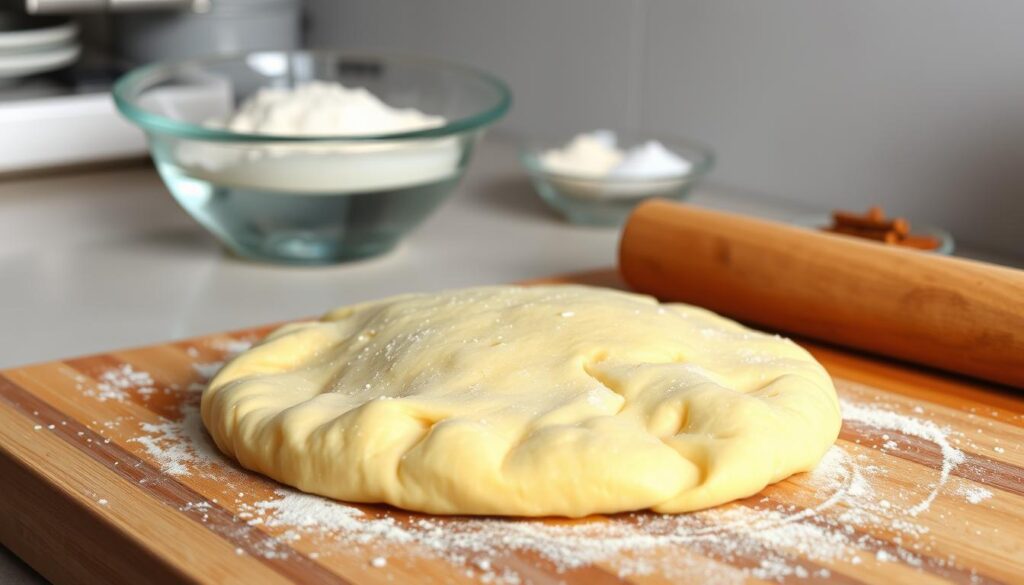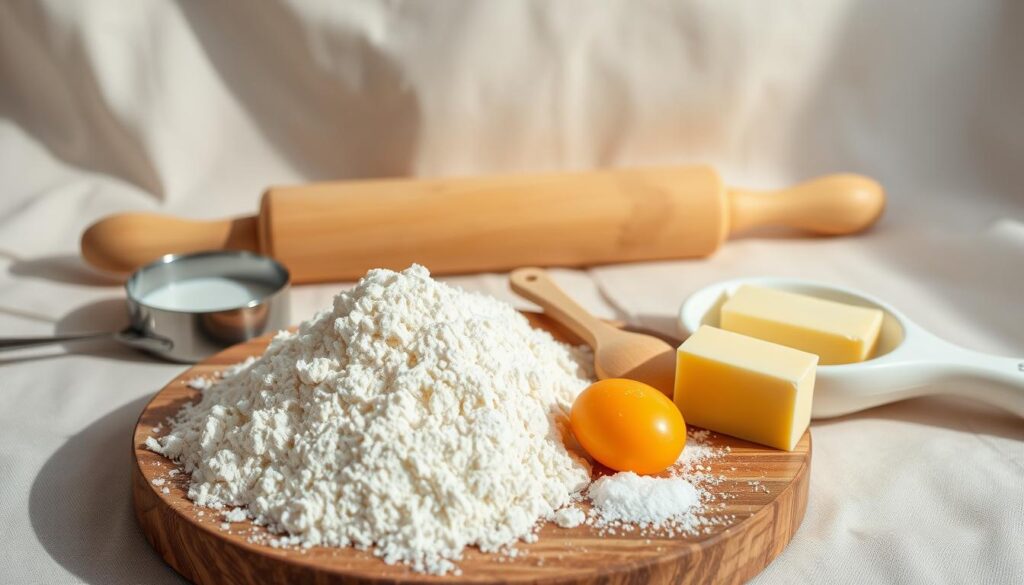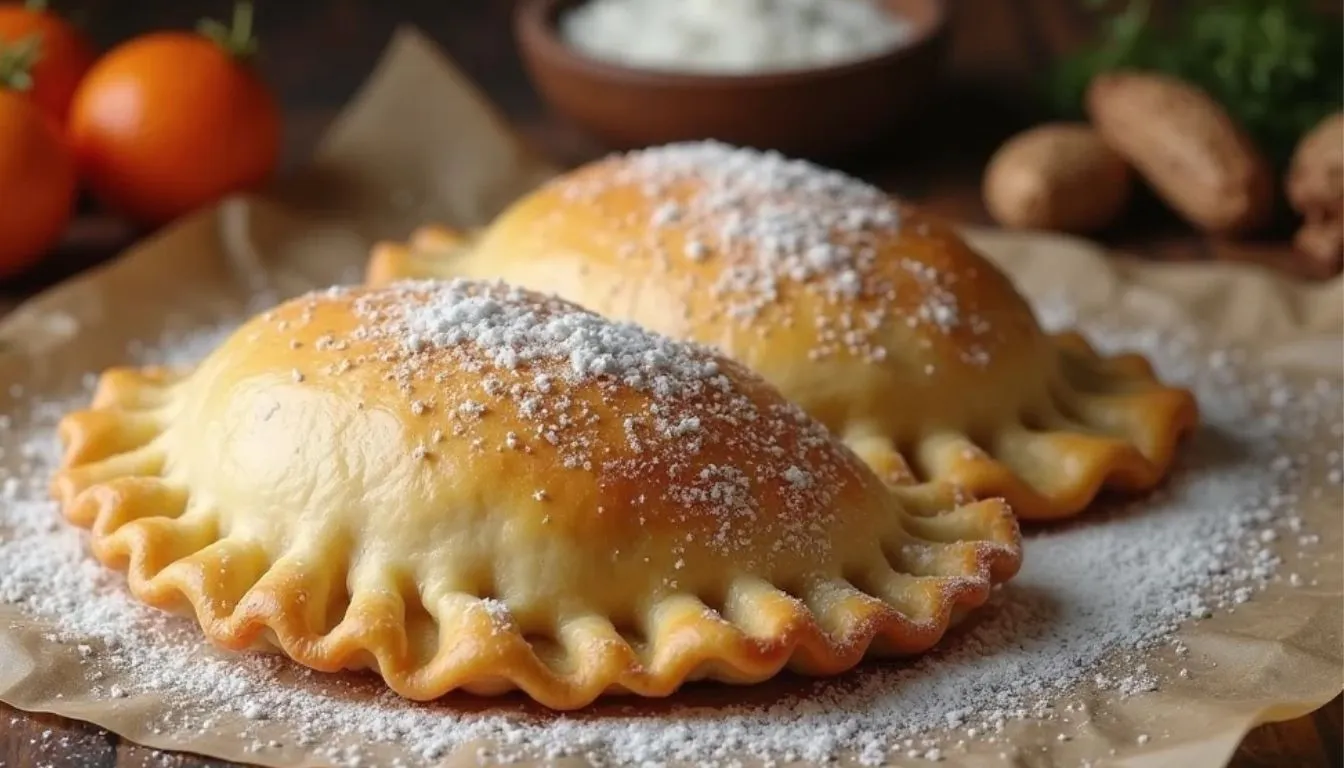Every kitchen has its own story, and mine started with a golden empanada dough. It connected me to generations of home cooks. Making homemade empanada pastry is more than just ingredients. It’s about keeping culinary traditions alive, warming both heart and plate.
Making an authentic empanada dough is easy. With simple ingredients and patience, you can turn flour, butter, and water into a flaky crust. This crust carries flavors from Argentina’s rich culinary scene. Whether you’re an experienced cook or just starting, this guide will help you every step of the way.
Imagine pulling a perfectly golden empanada from the oven. Its crisp exterior and savory filling remind you of family recipes passed down through generations. That’s the magic of making your own homemade empanada pastry.
Table of Contents
Understanding Traditional Argentinian Empanada Dough

Empanadas are more than a pastry in Argentina. They are a journey through South American cuisine. The dough’s story is one of cultural fusion and innovation.
History and Cultural Roots
The history of Argentinian empanada dough goes back to the late 19th century. Jewish immigrants brought their recipes, changing local cooking. This dough became a symbol of cultural exchange, mixing European methods with local ingredients.
Key Characteristics of Authentic Dough
- Vegan-friendly ingredients
- Simple composition of flour, salt, oil, and water
- Light and flaky texture
- Versatile preparation method
The authentic Argentinian empanada dough is simple yet amazing. It has just a few ingredients but creates a fantastic result. It’s great for both savory and sweet fillings.
Regional Variations
Every Argentine region has its own empanada dough twist. From the north to Patagonia, each area adds its own flavor. Some might add spice or use different flour ratios.
Knowing these differences lets you see the depth of Argentina’s culinary heritage. Whether you cook at home or love food, learning about the dough opens a window to Argentina’s rich food culture.
Essential Ingredients for Perfect Empanada Dough Recipe

To make the best empanada dough, you need to know the right ingredients. Your homemade empanada pastry ingredients are key to a delicious dish. They will take your taste buds on a trip to Argentina.
The main ingredients for great empanada dough are simple but important. Each one is vital for the dough’s texture and taste. This makes empanadas so loved by many.
- All-purpose flour: The primary base for your empanada dough
- Cold water: Essential for creating a tender, flaky texture
- Salt: Enhances the overall flavor profile
- Vegetable oil or unsalted butter: Provides richness and helps with dough elasticity
Choosing high-quality ingredients is essential for the best empanada dough. The flour you pick can greatly affect the dough’s outcome. Some prefer a mix of all-purpose and pastry flour for a softer texture.
| Ingredient | Purpose | Recommended Quantity |
|---|---|---|
| All-purpose flour | Structure and base | 2-3 cups |
| Cold water | Binding ingredients | 3/4 to 1 cup |
| Salt | Flavor enhancement | 1 teaspoon |
| Vegetable oil | Moisture and texture | 1/4 cup |
If you follow a special diet, you can try different flours. Remember, the secret to great empanada dough lies in the careful balance of ingredients and technique.
Kitchen Tools and Equipment Needed
Making the perfect easy empanada crust needs the right tools and preparation. Whether you’re new or experienced, the right equipment makes empanada-making fun and easy.
To start making an easy empanada crust, gather the right tools. You want equipment that makes the process simple and efficient.
Essential Tools for Empanada Dough Preparation
- Large mixing bowl (ceramic or stainless steel)
- Sturdy rolling pin
- Measuring cups and spoons
- Sharp knife or pastry cutter
- Baking sheet
- Parchment paper
Optional Equipment to Enhance Your Empanada Crust Experience
These tools are not necessary but can make preparing your easy empanada crust easier:
- Food processor for quick dough mixing
- Pastry mat for easy rolling
- Digital kitchen scale for precise measurements
- Silicone dough scraper
Surface Preparation for Perfect Empanada Dough
Your work surface is key for a great easy empanada crust. Clean, smooth countertops are best. Sprinkle flour lightly to prevent sticking.
Pro tip: A cool, clean surface keeps your empanada dough at the right temperature. This prevents it from getting too warm and hard to handle.
Step-by-Step Mixing Process
Making empanada dough is all about the mix. You need to blend ingredients with care and skill.
First, collect your dry ingredients in a big bowl. This is the foundation of your dough. Mix in flour, salt, and any extra seasonings you like.
- Sift flour to remove any lumps
- Measure ingredients precisely
- Use room temperature ingredients
Then, make a well in the dry mix. This makes it easier to add wet ingredients. Slowly add cold water and oil, mixing with a fork or your hands until it starts to stick together.
How you mix is important. You want to mix gently but steadily. Aim for a dough that’s smooth and not too tough.
- Mix until ingredients just combine
- Avoid overmixing the dough
- Stop when the dough forms a loose ball
Professional bakers say to use your fingers to check the dough. It should feel a bit tacky but not too sticky. It should also be smooth and easy to shape.
Proper Kneading and Resting Techniques
To make the perfect flaky empanada shell, you need to master kneading and resting. These steps are key to getting the right texture and structure for your dough.
Kneading Methods for Best Results
Kneading turns your ingredients into a smooth, elastic dough. This dough is essential for a delicate flaky empanada shell. Here are the main techniques:
- Work the dough gently on a clean surface
- Use the heel of your hand to press and fold
- Rotate the dough quarter-turn after each knead
- Maintain consistent pressure to develop gluten
Optimal Resting Times and Conditions
Resting is important for a tender and flaky empanada shell. The best resting process is:
- Cover the dough with plastic wrap
- Refrigerate for 10-15 minutes
- Keep temperature consistent around 40°F
- Prevent drying by sealing tightly
Visual Cues for Perfect Dough
Knowing when your dough is ready takes practice. Look for these signs of a perfectly prepared flaky empanada shell:
- Smooth, elastic texture without cracks
- Slight resistance when stretched
- Consistent color and texture
- Holds shape without springing back immediately
Rolling and Shaping Your Empanada Dough
Learning to roll and shape your empanada dough is key to making perfect empanadas. The right method ensures they cook evenly and look great. This will impress your family and friends.
Begin by cutting your homemade empanada pastry into 12 equal pieces. Work on a clean, lightly floured surface to avoid sticking. You want to make thin, even circles about 5 inches wide.
- Use a rolling pin with gentle, consistent pressure
- Rotate the dough frequently to maintain circular shape
- Aim for 1/8 inch thickness for ideal texture
Each empanada style needs its own shaping method. Here are a few popular ones:
| Shaping Method | Technique | Difficulty Level |
|---|---|---|
| Classic Crimp | Fold and press edges with fork | Easy |
| Repulgue | Twist and fold edges decoratively | Advanced |
| Simple Fold | Half-moon shape, press edges | Beginner |
Getting better at working with your empanada dough takes practice. Don’t worry if you’re not perfect at first. With each try, you’ll get better at making authentic, tasty homemade empanada pastry.
Storage and Make-Ahead Tips
Preparing your easy empanada crust ahead of time can be a game-changer for home cooks. Knowing how to properly store your dough ensures you’ll always have a delicious base ready for your favorite fillings.
When it comes to storing your homemade empanada dough, you have several convenient options. These options help preserve its quality and texture.
Refrigeration Strategies
Your easy empanada crust can be safely stored in the refrigerator with minimal preparation. Follow these guidelines to keep your dough fresh:
- Wrap the dough tightly in plastic wrap
- Place in an airtight container
- Store in the coldest part of your refrigerator
- Use within 3 days for optimal freshness
Freezing Your Empanada Dough
Freezing provides an excellent long-term storage solution for your easy empanada crust. Here’s how to freeze your dough effectively:
- Divide dough into individual portions
- Wrap each portion in plastic wrap
- Place wrapped dough in a freezer-safe bag
- Remove excess air to prevent freezer burn
- Freeze for up to 3 months
Thawing Instructions
Proper thawing is key to maintaining the quality of your easy empanada crust. Always thaw frozen dough in the refrigerator slowly. Avoid quick thawing methods that can harm the dough’s texture.
With these storage tips, you’ll always have a delicious empanada crust ready. It will transform your next meal into a culinary adventure.
Common Troubleshooting Tips
Making the best empanada dough can be tricky. Knowing how to fix common problems will boost your confidence in making this tasty pastry.
Moisture is key when working with empanada dough. If it feels too dry, don’t worry. Here are quick fixes to save your dough:
- Add water gradually – 1-2 teaspoons at a time
- Knead gently to mix in the extra liquid
- Let the dough rest for 10-15 minutes after adjusting moisture
Sealing empanadas can be a challenge. Prevent leaks and get perfect results with these tips:
- Don’t overstuff your empanadas
- Leave a small border when adding filling
- Press edges firmly with a fork
- Chill before baking to keep shape
Problems like stickiness or tearing can ruin your dough. Always work on a lightly floured surface. Handle the dough gently to keep its texture right.
Practice makes perfect. Every batch of empanada dough you make will get better. You’ll become a true pastry expert.
Best Filling Combinations and Serving Suggestions
Creating delicious empanadas starts with mastering traditional empanada dough. The right filling can turn your homemade treat into a culinary masterpiece. Your argentinian empanada dough is the perfect canvas for many mouthwatering combinations.
Classic savory fillings are at the heart of authentic empanada recipes. Here are some popular options:
- Carne Picante: Spicy ground beef with onions and red pepper
- Chicken with enchilada sauce and melted cheese
- Ham and creamy cheese blend
- Vegetarian options like roasted vegetable and quinoa
For those who love sweets, dessert empanadas offer exciting possibilities:
- Nutella and banana
- Apple pie filling with cinnamon
- Dulce de leche with fresh berries
- Guava and cream cheese
Serving suggestions can make your empanada experience even better. Try pairing them with fresh chimichurri sauce, a crisp salad, or a tangy salsa. For the best results, serve them right after baking. This way, you’ll enjoy the perfect crispy texture of your traditional empanada dough.
Pro tip: Adjust baking times slightly based on your chosen filling. This ensures a golden, crispy exterior and a perfectly cooked interior.
Conclusion
Making a flaky empanada shell is more than a cooking skill—it’s an art. It connects you to a rich culinary tradition. By learning to make homemade empanada dough, you’ve gained a versatile skill.
Creating an exceptional flaky empanada shell takes practice, patience, and passion. Every time you make dough and try new fillings, you’re part of a global cooking tradition. You’re empowered to make delicious, authentic empanadas that will wow your loved ones.
Cooking is about exploring and expressing yourself. Feel free to try new techniques, fillings, or your own empanada style. Your kitchen is a canvas, and the flaky empanada shell is your medium for creativity. Start making, learn, and enjoy every bite of your empanada adventure.
We encourage you to share your empanada creations on social media. Connect with other food lovers. Your culinary journey is just starting, and each flaky empanada shell tells a story of skill, tradition, and innovation.
Tried Our Recipe Yet?
There are no reviews yet. Be the first one to write one.

